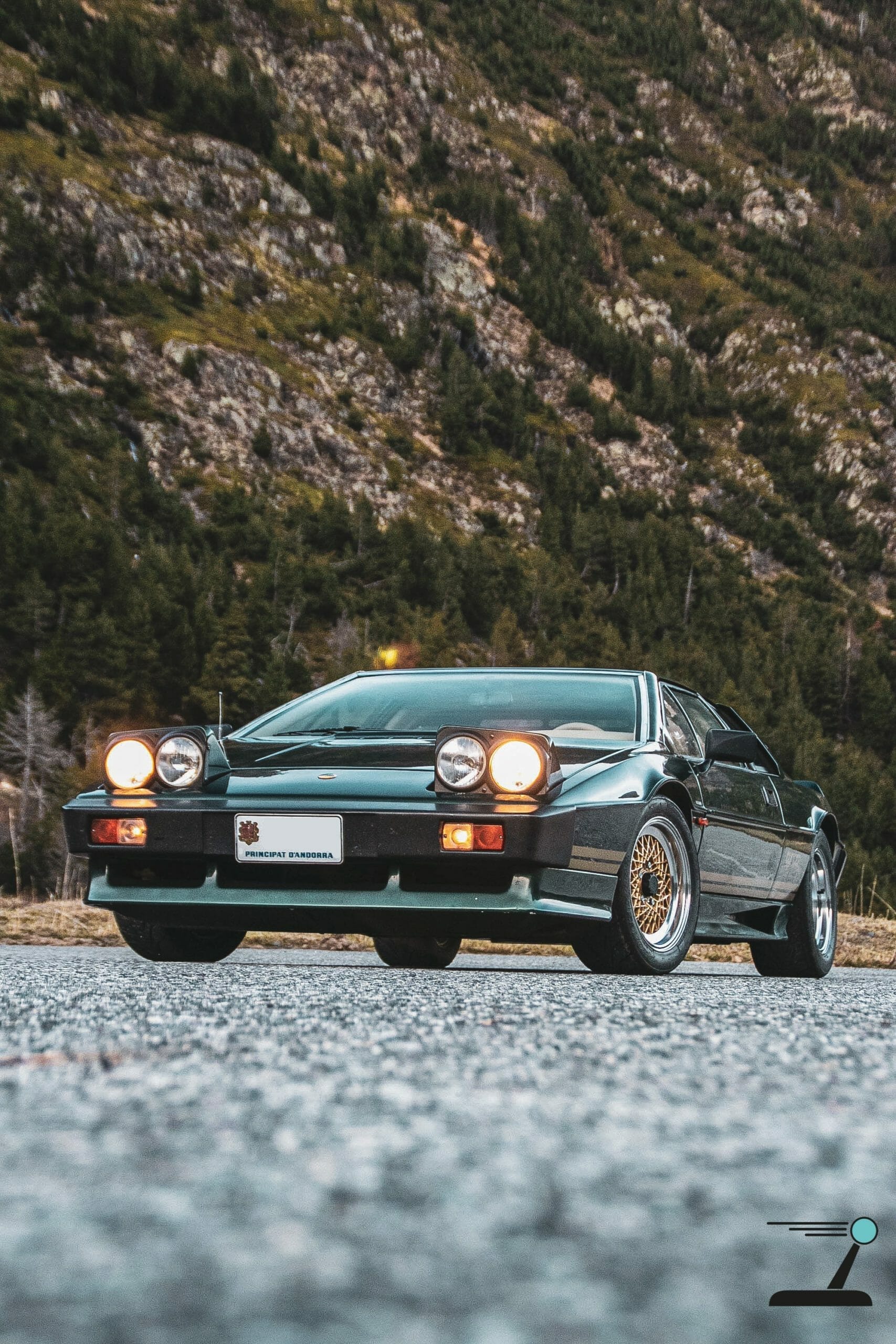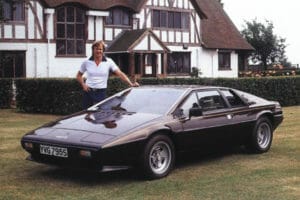The original Lotus Esprit launched in 1975 was one of the most dramatic looking sports cars on the market. Styled by Giorgetto Giugiaro at Ital Design, it earned much praise for its handsome lines and superb chassis dynamics.
However, the original Esprit lacked the kind of build quality and refinement expected of it.
Such criticism was addressed with the subsequent S2 and S2.2 variants of 1978 and 1980 respectively. These later iterations came with a host of upgrades as Lotus looked to create a machine that delivered in every area.
Because the Esprit was arguably the best handling car on the market, it was capable of running considerably more power than the 160bhp it came with for the first few years of production. Calls for more punch were answered with the arrival of the heavily reworked Type 82 Esprit Turbo in 1980.
The Turbo variant was initially launched in expensive Essex Commemorative trim as a homage to Lotus F1’s title sponsor, Essex Petroleum. In addition to the gaudy Essex colour scheme, Essex Turbos came with full leather upholstery, a state-of-the-art Panasonic roof-mounted stereo, air-conditioning and Sundym glass.
Sales were initially slow until Essex boss, David Thieme, was arrested by Swiss authorities in March 1981; Credit Suisse had extended Thieme a credit line for oil spot trading and accused him of committing a $7.6m fraud. Thieme was released on bail, but disappeared from F1 after the 1981 Monaco Grand Prix.

Lotus replaced the Essex logos on their F1 cars with those of long-term sponsor, John Player Special.
They were also quick to reconfigure their flagship production model; in April 1981, Lotus scaled back the Esprit Turbo’s luxuries, cut the price by over 15% and openly offered the car in conventional colour schemes. Demand quickly picked up.
A revamped normally aspirated Esprit based on Turbo underpinnings was also launched in April 1981.
The new Type 85 Esprit S3 replaced the Type 79 S2.2, which had been in production for little over a year.
Famous Faces with the Lotus Esprit Turbo.
Because the S3 used the same chassis, suspension, brakes and body tooling as the Turbo, Lotus were able to cut the price by 13% compared to its predecessor. However, it was not just cheaper than before; the S3 offered a quieter ride, improved handling, better braking, more cockpit space and a considerable step up in build quality.
For the Turbo, the original Esprit’s backbone steel chassis had been thoroughly reworked to accommodate revised suspension, offer improved access to the engine and allow space to install a secret V8 motor that was in development.
A beefier backbone chassis was thus created that featured wider box sections, new suspension mounting points and a new subframe for the engine and transmission. It was also zinc galvanised and given a five-year anti-corrosion guarantee.
The exact same arrangement was utilised for the S3.
Similarly, the S3 adopted the Turbo’s wide track front suspension that comprised upper wishbones, lower transverse links, coil springs and an anti-roll bar. Most of this equipment had itself been imported from the Elite.
At the back, the S3 used the Turbo’s non-parallel unequal length double transverse links, radius arms and coil springs. Both the S3 and Turbo also featured an extra rear upper link that had been added to alleviate strain on the half-shafts.
The Turbo and S3 brakes were improved too. However, Lotus found the latest ventilated discs lacked feel and longevity so larger solid discs were fitted instead. The fronts had a 10.5-inch diameter while the inboard rears measured 9.7-inches. A bigger brake master cylinder and servo were installed as well.
One area where the S3 and Turbo differed was the wheels.

Turbos came with 15-inch single-piece BBS cross-spoke wheels (7-inches wide at the front and 8-inches wide at the rear). These were an option on the S3 to replace the standard 14-inch JK rims that measured 7-inches wide at the front and 7.5-inches wide at the rear.
In the S3’s engine bay was the all-alloy, DOHC, 16 valve Type 912 inline four cylinder engine that had been introduced on the Esprit S2.2.
The 912 had been stroked from 69.2mm to 76.2mm because the the Type 907 that preceded it had already been bored to its natural limit of 95.2mm. Displacement rose from 1973cc to 2174cc as a result.
The 912 engine had been further improved over the 907 thanks to uprated camshafts, superior main bearing support panels, a new sump and a thin disc flywheel. New Dellorto DHLA 45E carburettors were also fitted. The compression ratio was dropped from 9.5:1 to 9.4:1.
Although the new motor was still rated at 160bhp (albeit at 6500rpm instead of 6200rpm), it provided considerably more torque: 160lb-ft at 4900rpm compared to 140lb-ft at 4900rpm. Fuel economy was also improved.
Transmission was once again via Citroen’s C35 five-speed gearbox and a single-plate clutch.
As per the Turbo, the S3 came with the big new bumpers that were a key aspect of Guigiaro’s latest Esprit revamp.
It also featured the distinctive body coloured engine intakes mounted behind the rear quarter windows.
What the S3 didn’t get was the Turbo’s deep front air dam, side skirts, aggressive rear spoiler or louvred engine cover. Instead, it came with its own slimmer front spoiler, simpler sill mouldings and a glazed rear hatch.
Despite lacking the Turbo’s aggressive looks, the S3 was a fine looking machine.
The Competitors of that time:
from 1983 – Motor magazine Road Test
Interior
Inside, the cockpit retained the same basic layout as the Turbo which, thanks to body mould changes, offered more headroom and larger footwells than the Esprits that came beforehand.
Standard upholstery was velour fabric.
 Compared to the S2.2, the S3 featured a new sound insulation barrier that cut cabin noise by 50%. It also came with the Turbo’s twin-spoke steering wheel, but no cigar lighter.
Compared to the S2.2, the S3 featured a new sound insulation barrier that cut cabin noise by 50%. It also came with the Turbo’s twin-spoke steering wheel, but no cigar lighter.
Standard equipment included electric mirrors, electric windows, a heated rear window, tinted glass and two audio speakers.
Buyers could enhance their cars with a number of optional extras to include air-conditioning, leather upholstery with cloth inserts, full leather upholstery, metallic paint and the aforementioned BBS wheels.
A stereo radio cassette player could also be specified as could a separate amplifier and four speakers.
Lotus quoted a kerb weight of 1120kg, a top speed of 138mph and a 0-62mph time of 6.5 seconds.
Press and public reaction was extremely favourable; in many respects, the S3 was the car the Esprit should have been from day one.
S3 production came to an end in late 1987 ahead of the introduction of the revamped X180 Esprit in 1988.
1053 S3s were built in total.
(Text and information from Supercar Nostalgia )

This Lotus Turbo Esprit Type 85 was bought new by the Owners Father in Dezember 1984 straight from the Lotus Factory in British Racing Green with Beige Leather Interior. The Family owned Car was refurbished from 2013 till 2017 with a special eye to keep its originality. Therefore the original paint was not touched. The Odometer of this Ar shows 85.000km. Since the restoration, only 2000 were driven with it. See a Review done by coches.net of this Car:
Cover the Insurance with our Partner and only pay € 378,-/per anum. Calculate it here
The vehicle description is provided to the best of the seller’s knowledge and belief. We at Getyourclassic use our experience to work with the seller to provide a correct and accurate vehicle description. However, the bidder must satisfy themselves as to the accuracy of the description and make all necessary enquiries before placing a bid. Our General Terms and Conditions apply exclusively.
| Year | 1984 |
|---|---|
| Make | Lotus |
| Model | Esprit Turbo, Type 85 |
| Colour | British Racing Green |
| Engine | DOHC, 16 valve Type 912 inline four cylinder |
| Displacement | 2174cc |
| Horsepower | 214 |
| Kilometers | 85.000 |
| Location | La Seu d'Urgell, Spain |
Total Bids Placed:
Auction has expired
Highest bidder was: AV
| Bidder Name | Bidding Time | Bid | Auto |
|---|---|---|---|
| AV | 20. February 2022 12:53 | 55.000,00€ | |
| throttleout | 20. February 2022 12:11 | 53.900,00€ | |
| AV | 20. February 2022 10:42 | 50.000,00€ | |
| ADJ | 19. February 2022 19:19 | 47.900,00€ | |
| throttleout | 19. February 2022 15:27 | 45.900,00€ | |
| ADJ | 19. February 2022 13:19 | 41.900,00€ | |
| Haschu | 19. February 2022 11:36 | 38.500,00€ | |
| ADJ | 19. February 2022 10:36 | 37.900,00€ | |
| throttleout | 18. February 2022 19:44 | 35.000,00€ | |
| ADJ | 18. February 2022 16:18 | 23.900,00€ | |
| BirgitBB | 15. February 2022 22:03 | 18.900,00€ | |
| SDYX | 15. February 2022 21:40 | 15.200,00€ | |
| BirgitBB | 10. February 2022 17:14 | 14.800,00€ | |
| throttleout | 10. February 2022 16:13 | 3.500,00€ | |
| Auction started | 9. February 2022 20:00 | ||
Buyer's Premium
| Buyer's Premium | 9.6% of Winning bid. |
|---|























Hi, how much would the import tax or any other taxes be to bring it to Spain? Any idea?
Car is registered in Spain now, with historical Spanish plates